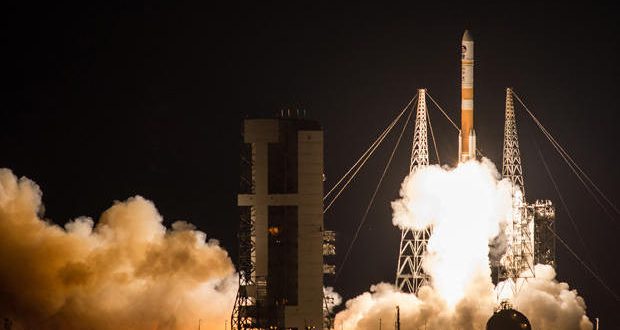A United Launch Alliance Delta IV rocket successfully launched from Cape Canaveral Air Force Station Saturday to deliver a communications satellite into orbit.
The rocket, which is carrying a military communications satellite, was scheduled to lift off at 7:45 p.m. from Space Launch Complex 37.
The launch was delayed until 8:18 p.m. due to a technical issue.
WGS satellites help the Department of Defense grapple with its growing need for bandwidth, especially for troops in the field. Four solid rocket motors were expected to help Delta IV vault the $424 million satellite to orbit from Cape Canaveral Air Force Station’s Launch Complex 37.
ULA hopes to follow that next week with a launch of International Space Station supplies on an Atlas V rocket. The mission is scheduled for around 9 p.m. next Friday, March 24, but would move up a day to Thursday, March 23, if the range becomes available.
Departing from the Cape’s Launch Complex 41, Atlas V will help deliver a Cygnus spacecraft loaded with nearly 7,500 pounds of cargo to the space station for Orbital ATK and NASA.
Kicking off this busy week, the 229-foot Falcon 9 rocket lifted off from Kennedy Space Center at 2 a.m. Thursday into a clear, dark sky and deployed the EchoStar 23 communications satellite 34 minutes later on its way to an orbit more than 22,300 miles over the equator.
The rocket needed all its fuel to lift the more than 12,300-pound satellite to a high orbit, so SpaceX did not try to land the Falcon booster, which was not equipped with landing legs.
Thursday’s Falcon 9 launch was SpaceX’s second from historic pad 39A at KSC, from which astronauts first launched to the surface of the moon on Apollo 11 in 1969.
Englewood, Colorado-based EchoStar Corp. will use EchoStar 23 to provide direct-to-home television service to Brazil. Built by Space Systems Loral, the satellite is designed to operate for at least 15 years.
The mission continued SpaceX’s rebound from a Falcon 9 explosion last September during a test on the pad at Cape Canaveral Air Force Station’s Launch Complex 40.
SpaceX changed how it loads high-pressure helium tanks, and the Falcon returned to flight in January with a launch of Iridium Communications satellites from California.
Falcon 9 now has launched successfully three times this year and 30 times overall since its debut in 2010.
The company’s next mission, possibly in late March or early April, will be among its most closely watched. It will be the first re-launch of a Falcon booster recovered from a previous mission, tasked this time with lifting a commercial communications satellite for Luxembourg-based SES.
A successful flight would prove that Falcon rockets can be reused – an essential advance, SpaceX CEO Elon Musk believes, needed to lower launch costs and one day send people to Mars.
The EchoStar mission lifted off on its second attempt. Strong winds scrubbed a first try on Tuesday, and pushed back Thursday’s targeted liftoff time by 25 minutes.
Agencies/Canadajournal
 Canada Journal – News of the World Articles and videos to bring you the biggest Canadian news stories from across the country every day
Canada Journal – News of the World Articles and videos to bring you the biggest Canadian news stories from across the country every day



